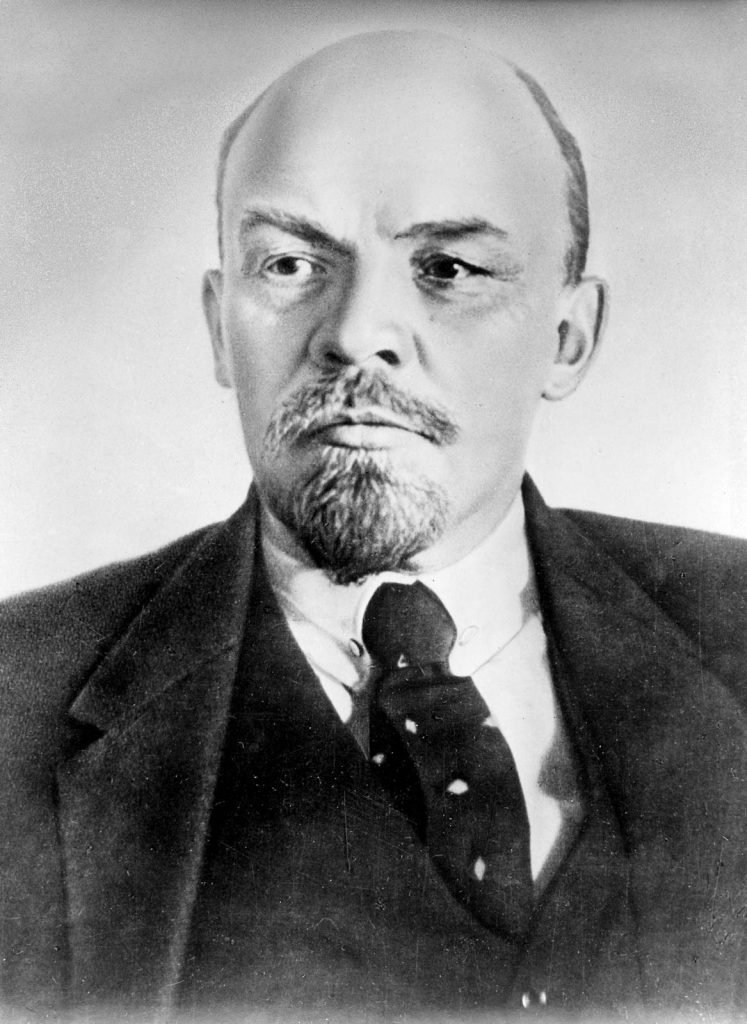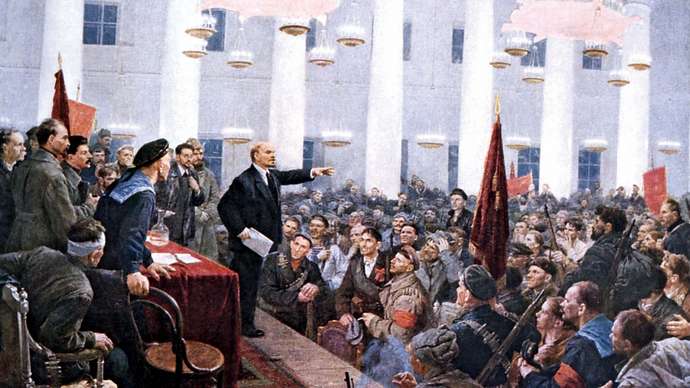Lenin and Early Life

Vladimir Lenin was born Vladimir Ilyich Ulyanov on the 22nd of April 1870 in Ulyanovsk, Russia. His father was a member of the lower noble class and worked as a school inspector, and his mother came from a somewhat middle-class family. Lenin was first interested in revolutionary politics after the execution of his brother, Aleksandr, in 1887. He was expelled from Kazan University after participating in anti-tsar protests. He then went on to earn a law degree and moved to St Petersburg in 1893, where he became a senior Marxist activist. He was arrested in 1897 and then exiled for three years. After the three years, he moved to Western Europe and became a prominent Marxist theorist. In 1903, after the split of the Russian Social Democratic Labour Party, he led the Bolshevik faction in opposition to the Mensheviks.
Lenin, the February Revolution, and the Provisional Government
Lenin arrived in St Petersburg about a month after the February Revolution and the forced abdication of Nicholas I, His arrival ignited a passion amongst his former comrades, many of whom returned to his side. Although there were many politicians who were supportive of the Provisional Government and what it was trying to achieve, Lenin deem it ‘unworthy of the support of the Socialists’ – he thought that it would never be able to total peace to the land, or to truly satisfy the needs of the workers. Although, Lenin’s party, the Bolsheviks, were a minority party at the time, the tension between the Provisional Government, the Bolsheviks, and all the other left-wing political parties led to what Lenin describe as the period of Dual Powers. He believed that the true power lied within the union, or the ‘Soviet’ formed by the left wing parties in St Petersburg, and that this power had been relinquished the the Provisional Government, the other smaller power in the land. In order for the workers to actually seize the power, Lenin believed that the people must rise up again and overturn the Provisional Government and those Socialists who would agree with them. This idea was so radical at the time that the ‘moderate socialists’ thought him mad, and even his own party thought that he must have become overwhelmed by the complexity of the situation.
Eventually, he convinced his party that he was right to support the overthrow of the Provisional Government and between March and September 1917, although the Bolsheviks were still a minority within the Soviet at this point, they campaigned for support. By the beginning of Autumn 1917, the Provisional Government was losing popularity due to failure to end the war and ongoing food shortages, and people had instead begun to support the more radical Bolsheviks, and by September, the Bolsheviks had become the majority party within the Soviet Council.
Lenin and the October Revolution
After the Bolsheviks became the majority within the Soviet, Lenin, who had been staying under the radar after being accused of being a German Spy by the leader of the Provisional Government in July, remerged and decided that it was time to take the power back from the Provisional Government, who he believed simply upheld imperialist ideals and could never represent the working class. In order to do this he needed to organise an armed uprising to dispose of them and to transfer power back to the Bolshevik-led Soviet.
Before the Russian revolution, most left-wing politicians in Russia believed that the standard democratic government could be used as a tool to implement both capitalist and communist systems, however, by September 1917, many had become disillusioned with that idea. This was largely due to the emergence of the new democratic council, the Soviet, which had been doing a far better job represent the working classes than any democratic organ had done before. It was because of this than Lenin believed the Soviet council was the way forward – the choice was between a democratic council representing a property-owning minority, in the way it always had before, and a Soviet council, representing the majority of property-less working class majority. Lenin, unsurprisingly, opted to support the Soviet.

Sometime around the 20th of October 1917, Lenin snuck into St Petersburg to attend a Bolshevik Central Committee meeting that was held on the 23rd. It took a 10 hour long debate, but he finally won a clear majority support for an armed takeover and started training Red Guards, a Bolshevik-led workers’ militia, for an assault on the Provisional Government. On November 7th and 8th, they took overt the Government and proclaimed that state power had finally been passed into the hands of the Soviets, who them overwhelmingly voted to accept full power and to elect Lenin as the chairman of the Council of People’s Commissars (which was the name for the new Soviet Government). One of there first moves in charge was to pass Lenin’s Peace and Land Decrees.
It was difficult for Lenin to consolidate his power over Russia as he was faced with dissidents from all sides. The Mensheviks and the ‘right-wing’ Socialists refused to form a coalition Government on Lenin’s terms and so were not included in the Soviet Government. In January 1918 these two groups were included in the meeting of the Constituent Assembly and, when they rejected sovietism, Lenin ordered the disassembly of the council.
The Allies also refused to support a Soviet Government which then meant that Russia had to enter into peace negotiations with the Central Powers alone, which was clearly a less powerful negotiating position than if Russia had been negotiating with the Allies at their side. The conditions proposed in the peace treaty that was offered to Russia were terrible. It determined that the western belt of nations that used to be part of the Russian Empire would be stripped away and the left communists desperately opposed this. Lenin, however, could understand that the Russian people were longing for peace and so declared that the treaty must be accepted, or he would resign from government. In March 1918, the Treaty of Brest-Litovsk had lost Russia a lot of land, but they were finally at peace.
This loss of land and perceived humiliation, however, only served to intensify the opposition to the Soviet Government both within Russia and from the Allies. This opposition was then made even worse by Lenin’s decision to both refuse the repayment of foreign loans that were taken out under the tsarist regime, and his decision to nationalise properties of foreigners within Russia without compensating them. This then led to the breakout of a Civil War, which lasted from 1918 until 1920.
The Soviet Government did eventually win the Civil War and crush their opposition, but there was an incredible number of casualties; on top of this, Lenin made a series of rules and choices that left the peasants upset and threating mass rebellion. This all led to an unhappy governing system in Russia that was lacking foreign support.
Lenin as a Leader
Although the idea of a Soviet government representing the people is a pleasant one, this is far from the truth of what Lenin actually created. Lenin’s government was a dictatorship. No political parties other than the Communists were allowed, and by 1922, Lenin possessed complete control of the Communist party and government. He also introduced propaganda to further the idea that he was the ‘father’ of the nation. Only communist newspapers were allowed, which meant that the Russian people would only hear what Lenin wanted them to.
In 1917, Lenin established his own secret police force, the Cheka, which was the dissolved and replaced by the GUP in 1922. Lenin was also responsible for the introduction of the Gulag system of work camps, intended to contain any opponents to his regime, in September 1918.
By the time Lenin died the Gulag had imprisoned tens of thousands of victims and he had truly created the first totalitarian dictatorship.
Lenin’s Death
Not long after the end of the Russian Civil War, Lenin fell ill. In the April of 1922, a bullet was removed from his neck that came from an earlier assassination attempt in 1918. He did seem to recover for a month or so, but then fell ill again, becoming partially paralysed. He recovered again somewhat in June and threw himself into political defensive moves to oppose the possible assentation of Joseph Stalin to power, an idea that Lenin vehemently rejected. He withdrew from active leadership and spent his time trying to mitigate strong personalities like Stalin and Trotsky. He suffered a stroke in March 1923, and then another on the morning of the 21st of January 1924, which he died of that evening.